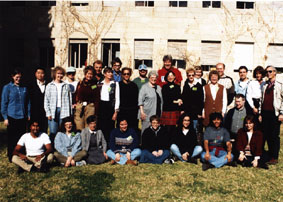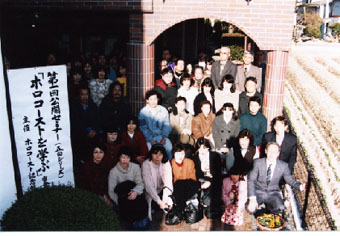LEARNING FROM THE HOLOCAUST

Makoto OTSUKA, Director General of the Holocaust Education Center, Japan
Holocaust, which is said to be the worst tragedy of the 20th century, is an outcome of ignorance and indifference. The Holocaust is widely known as the most serious crime in human history from many respects, and geographical areas associated with Holocaust extend over 25 countries, from Europe to Russia. The number of people who were killed just because they were Jews totalled 6 million, of whom 1.5 million were innocent children. We must look directly at these facts, and we must not repeat this tragedy again in the future.
Systematic and intentional genocide
The peculiarity of the Holocaust was that genocide was carried out systematically and intentionally under the ideology of exterminating Jewish people. When we study the history of Europe - Italy and Spain for instance - we realize that many innocent people suffered from misunderstanding and defamation accumulated over many years. In Great Britain, Germany, France and Russia, there was also the fact of expulsions and genocide which were carried out against Jews. Hitler used this hatred and prejudice which had grown in the soil of Europe.
When the Nazis tried to expel Jews for the first time, hardly any countries would accept them. There were too few people who raised protests even though they knew the facts of the genocide taking place.
Undoubtedly, it was the clumsy reactions of the world that gave great impetus to Hitler’s plan of exterminating Jews. Taking this position, I believe we should perceive the issue of the Holocaust as one for all of mankind, rather than for particular individuals or groups.
Cattle trucks which carried Jews, brutal forced labor, gas chambers and crematoriums—all these represent the acts of human beings in the 20th century, which were done to similar human beings. These were the acts of those who were leading the modern civilization in fields such as medical science, chemistry, engineering and music. Moreover, Hitler did not come to power by a coup d’etat, but was elected legally by plebiscite.
"My name is Otto Frank, father of Anne Frank." Twenty-six years ago, I met an elderly gentleman by chance during a trip. This was my first encounter with the Holocaust. Mr. Frank was the only one in his family who survived from Auschwitz, the hell of human creation.
Despite his tragic experiences, he seemed to have overcome his past and believe in future. In Basel I was impressed by the sight of him writing answers to the letters which he had received from children all over the world.
" Please don't just sympathize with Anne, but try to become a person who will do something to create peace. Peace grows out of mutual understanding," he appealed.
Learning from History to Create Peace
Our center is an educational center, directed towards children, with a motto according with Mr. Frank's will, "Small Hands, Create Peace." We did not prepare model answers here at our center, considering rather that the children can seek their own answers by seeing the photos of the children of those days, displayed together with art and other materials. The exhibitions are set up at the height of children’s eyes, and we selected the explanations as much as possible from the words of children of those days. To these exhibitions, we have received responses such as "I would like to find something to create a peaceful world." Living study has begun. Over 15,000 people have visited here since the opening.
What Counts is the Transmission of the Fact
Last fall, I attended the First International Conference on the Holocaust and Education held in Jerusalem, and had an opportunity to give a presentation. I learned about the methods of history teaching being practiced in 17 countries all over the world. In Europe and the USA, besides learning the history of the Holocaust, they are laying emphasis on how to make the most of the lessons of the Holocaust in the present and the future.
In Japan, since a magazine article had been published which denied the fact of the Holocaust, saying as "There were no gas chambers," the Holocaust has been introduced through movies and publications very rapidly recently. Until today, I have met many Holocaust survivors and visited concentration camps and Holocaust museums. I strongly feel the importance of teaching and transmitting the facts of Holocaust.

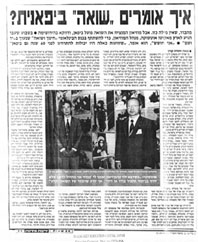
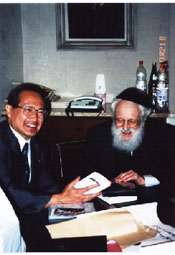 Rabbi Alexander Safran, who lives in Geneva, Switzerland, has won distinction as a rabbi presenting the Holocaust to people today. He has written about his own experience of the Holocaust in many books, and he sent the most representative one to the Center last year. He was already 86 years old, and seemed somewhat ill when I met him, but he was waiting eagerly for my visit.
Rabbi Alexander Safran, who lives in Geneva, Switzerland, has won distinction as a rabbi presenting the Holocaust to people today. He has written about his own experience of the Holocaust in many books, and he sent the most representative one to the Center last year. He was already 86 years old, and seemed somewhat ill when I met him, but he was waiting eagerly for my visit.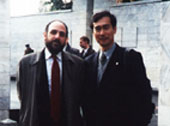 In Warsaw, I met again Rabbi Michael Schudrich, who served few years in Tokyo and now serving as Rabbi for the only remaining synagogue in Warsaw from the time of the Holocaust. When I visited the monument of the ghetto and Hollandsche Schouwburg former center station for the deportation with the rabbi, he told me, "From here, Jews were sent to Treblinka and Auschwitz. Also was Pan Doktor Janusz Korczak." Closing my eyes in the silence, I heard the rattles of the train. As a teacher who concerns about Holocaust education, I got challenges everywhere. The fact about rescuers and victims touched my heart so much.
In Warsaw, I met again Rabbi Michael Schudrich, who served few years in Tokyo and now serving as Rabbi for the only remaining synagogue in Warsaw from the time of the Holocaust. When I visited the monument of the ghetto and Hollandsche Schouwburg former center station for the deportation with the rabbi, he told me, "From here, Jews were sent to Treblinka and Auschwitz. Also was Pan Doktor Janusz Korczak." Closing my eyes in the silence, I heard the rattles of the train. As a teacher who concerns about Holocaust education, I got challenges everywhere. The fact about rescuers and victims touched my heart so much.